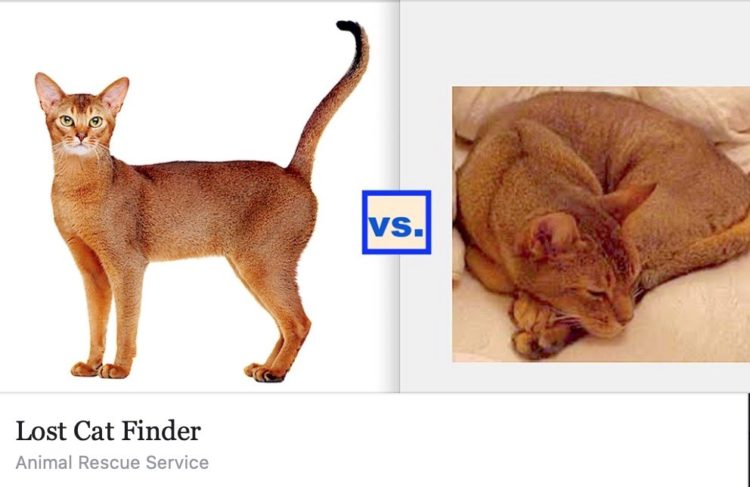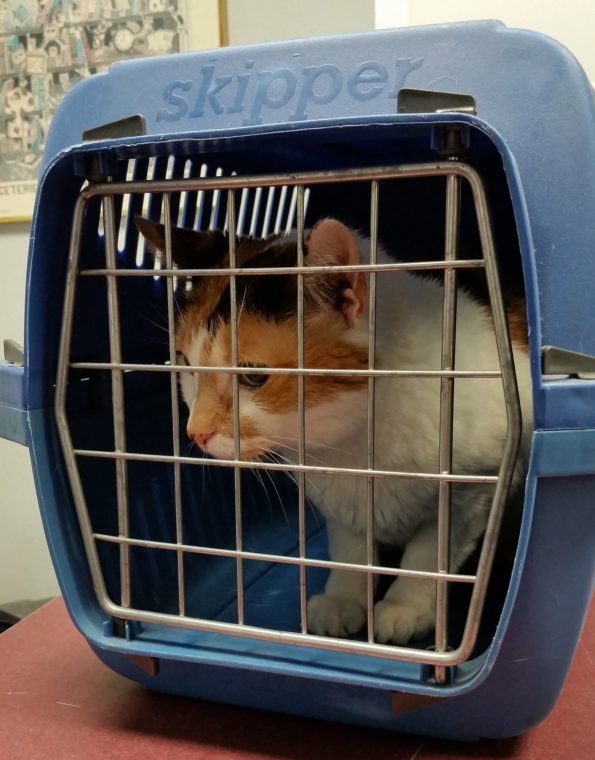2020 Lost Cat Tips & Prevention
Kim Freeman, Cat Detective at www.LostCatFinder.com
A guest post from the Lost Cat Finder Kim Freeman, who does search & rescue for missing cats.
With our increased time at home and new routines, here are some new tips for 2020 to prevent your cat from escaping when kids are careless, door accidents happen, and search access is limited.
Cats are more difficult to recover than dogs and require special techniques beyond social media, flyers, and a visit to the shelter. Would you know what to do if someone left a door open and your cat slipped out?
Take these steps to prevent your cat from making a sneaky exit and know how to be ready in case of this emergency situation.
HAVE THE PERFECT PHOTO READY
Take a special photo of your cat so you have the ideal pose for a lost cat flyer and poster. The most useful image is your cat standing in a side view (including their tail) facing the camera. This helps if someone spots your cat flash past outdoors. I find that most people have cute sleeping poses or silly cute kitty photos, but rarely a simple standing side-view. Take one now, just in case you ever need it!

PREPARE A LOST CAT KIT
With their normal routine upset and everyone home so much, cats who are used to having the entire place to themselves may be stressed and eager to slip out, especially in the spring and summer months.
Store photos, microchip number and a mock-up lost cat flyer with your cat’s Emergency GO Kit or simply where it’s easy to access. Should you ever need them, this kit will save you precious time and tons of stress. The ultimate preparation is to skim or download the ebook, the Professional Guide on How to Find a Lost Cat so you know the right steps for your situation – as well as the common mistakes to avoid (like putting out food and kitty litter).
SECURE YOUR BORDERS
Take ten minutes to check along perimeter of your fence for any spaces or holes that you could fit a closed fist into. Cats can get through tiny spaces, so add rocks or pack dirt to close them up. Cats can jump five times their height, so unless you have secured the holes AND have a catio or roll-top fence, your cat may surprise you with ninja escape abilities.
Remove any items leaning on or next to your fence. Woodpiles, garbage containers, kid toys, boxes, etc. next to a fence are a great springboard for cats to get over any fence, so make sure you are not offering an easy hop up and over – but no way to get back.
GPS TRACKERS
Everyone seems to think GPS is the ideal solution for lost cats, but it’s actually less than ideal because it depends on Global Positioning Satellites when cats hide tend to hide UNDER things.
For owners who insist on GPS (despite the research) a new device I’m field testing is the PAWTRACK collar. This is a good solution for cats as the hardware is part of the collar instead of a big box attachment. Even better is that it’s weighted so the communication unit is always up, facing the sky. This has to be recharged nightly, which involves taking it apart, switching out batteries, and plugging in overnight.
If your cat gets out, their “heavy necklace” is useless if the 48-hour battery has died.
An alternative system few people know about are the RF cat tracking devices, which are smaller and based on radio waves that can find cats under things like decks and porches –even down storm drains.
Even simpler and totally independent of glitchy apps, SIM cards, and texting plans is a simple LED lighted collar strip. The glow will show where your cat is hiding, whether as under a car, behind bushes, or up a tree. This is especially useful for cats who go out, but hide when it’s time to come back in at night.
PROOF OF OWNERSHIP
Be able to offer proof you own your cat in case someone takes him in. The best method to show proof of ownership is to have your pet microchipped. Check with your local shelter, rescue groups, or veterinarian to get this simple, inexpensive procedure.
Take a close-up photo of your cat’s nose and whisker pattern as these two features are unique to every cat, just like human fingerprinting. If your pet has any special markings, scars, or ear nicks, photograph these areas and keep these photos in a special location with your cat’s vet records.
SAFE TRANSPORT
This sounds basic, but you’d be surprised how many pet owners put their cats at risk. A cat inside a car can escape when involved in a traffic accident.  They can jump out prematurely when a door is opened (see case of cat lost at a gas station at night). Cat carriers have been known to break open during traffic accidents, in vet parking lots, and on conveyor belts at airports.
They can jump out prematurely when a door is opened (see case of cat lost at a gas station at night). Cat carriers have been known to break open during traffic accidents, in vet parking lots, and on conveyor belts at airports.
No matter how crabby your cat becomes with confinement, make sure you transport them in a secure carrier. Most accidents I’ve seen were the result of a “clamshell carrier” being dropped or the bottom falling out. There seem to be fewer incidents with zipper carriers–as long as you make sure the zippers are fully closed every time.
Image by paperelements from Pixabay
ORANGE COLLAR & MICROCHIP
Even if you never let your cat out, you never know when an emergency will happen. A kid may open a window or door at night, cat carriers can (and do) break open, or worst of all, a burglar could break in, leaving a door open for your cat to escape outside. Paramedics and other first responders often leave doors open during emergency procedures. I’ve even had cases of cats thrown from cars in traffic accidents.
Most people never think any of this could happen to them. Then it does. A bight collar with ID and a microchip are both important so your cat has identification both inside and out.
Even indoor-only cats should have a collar and chip because if they ever do get out, they’re at risk of ending up in an animal shelter months after you’ve stopped searching.
For collars, orange is known as the most noticeable color. It’s also known in the cat world as the sign of an escaped cat, so people will take note. In addition to orange, a lighted collar to be seen at night that’s also wide enough to accommodate big ID lettering is ideal for cats who will not let strangers pick them up or even get close enough to check a tag. A lighted collar makes them easy to spot at night.
Get your cat chipped this week, then go home and register the chip to YOU at your CURRENT address and phone number. Otherwise, it’s just a unknown number with no way to reach you.
NOTE YOUR CAT’S HABITS
Get to know when your cat sleeps, what hours they are the most active, and whether they prefer to be up in high places or down low. All this will be useful info should your cat ever get out. If they are allowed outside, take note on which way they go when leaving, how they behave, where they seek cover, and what yards they tend to visit. Get them used to being picked up and put back down.
Above all, if your indoor cat does slip out the door, resist the urge to chase or you may never see them again. Stay calm, keep an eye on them, and try to lure them back by sitting near your doorstep or near a dark/shady area with an open can of tuna. Learn how to do the “kitty Burrito wrap” in case you ever need to scoop up a cat you will need to carry more than ten feet.
BE NEIGHBORLY
In case your cat ever disappears make sure your neighbors know you have a cat –whether your cat is indoor only or outdoor-access. That way, they know who it belongs to and will be more likely to call when spotted. If you’re not already a member of Next-door, sign up and add your pet to their local pets file.
If your cat routinely roams and stalks birds, walks on cars, or poops on your neighbor’s property, make sure to preempt any complaints: ask neighbors to let you know if your cat is a problem for them in any way.
BIRD ALERTS
Should your cat ever escape and you have no idea which way they went, listen to the birds. They will make racous alarm calls to let each other know there is a predator in the area. Listen to bird language so you know when your cat has been spotted by these air spies.
Blue jays and mockingbirds are especially vocal when they spot a cat. Examples of various bird alarms on cats are included in the ebook, How to Find a Lost Cat by the Lost Cat Finder.
HOME RELATIONS
If your cat slips out, even for just a few hours, beware of the dynamics if you have other cats. Your recovered cat “smells different” and may not be immediately accepted back by the others, creating potential conflict.
Rather than assuming your cats are mad, vengeful or crazy, look into what’s creating the stress and how it’s displayed. Think of it as a cry for help, and get help! Friends will have their opinions, but find out from your cat’s point of view what is really going on with a consult with Val Heart.
Kim Freeman
“The Cat Detective”
Lost Cat reunion stories
https://www.facebook.com/LostCatFinder
Image by Philipp T from Pixabay
If you’re ready to start your journey in the wonderful world of Animal Communication, it’s time to start!
Download my FREE Ebook: Hidden Secrets to Communicating with Pets HERE.
Or dive into the complete Talking With Animals program with my Beginning Core Foundations Animal Communication Course.
Maybe you’ve already begun your journey in Animal Communication. If so, it’s time to go to the next level.
Find out how to access the Masterclass here
All my courses are fully guaranteed, so there’s no risk to taking the next step.
Enjoyed this article? Here are three more to help you:
Is Your Pet Afraid of Fireworks or Storms?
How to Keep Your Pets Safe From Coyotes
COVID-19 and Mother Earth Gaia’s Perspective, I Wonder?
The post Preparing an Emergency Lost Cat Covid Kit appeared first on Val Heart.
source https://valheart.com/preparing-an-emergency-lost-cat-covid-kit/?utm_source=rss&utm_medium=rss&utm_campaign=preparing-an-emergency-lost-cat-covid-kit
No comments:
Post a Comment